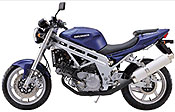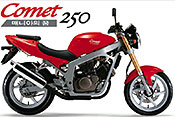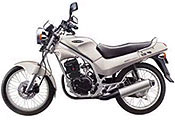Kinetic''s Comet 250GT
By Our Automotive Bureau | 22 Jul 2004
A strong performance combined with good ride and handling makes the Comet 250GT a machine that is at ease in the city as well as on the highway.
 Kinetic
Engineering will soon launch the Hyosung Comet 250 in
India. Expected to be a limited edition run, its price
will be close to two lakhs.
Kinetic
Engineering will soon launch the Hyosung Comet 250 in
India. Expected to be a limited edition run, its price
will be close to two lakhs.
Hyosung Motors of Korea had made a back door entry into the Indian market in 1999. Popularly called the Hyundai of two-wheelers, Hyosung entered into collaboration with Kinetic to introduce a number of products, the first of which a bike called the GF125 hit the market in 2001.
An improved and powerful version of this bike, the GF170, was launched last year. A little before that, 100 of Hyosung''s 250cc-cruiser bikes, called the Aquila, were brought in from Korea as CBUs for a limited edition sale in various Indian cities. With the assurance of full service back up, the market snapped up the Aquilas despite their hefty price tag of Rs150,000.
The response, according to senior company executives, has forced Kinetic into considering doing a similar launch for the Comet 250. Unlike the Aquila, the Comet is a proper roadster meant for sporty riding and is currently undergoing homologation at ARAI and will be ready to hit the market by the end of this year.
Structured on a wheelbase of 1,455mm the Comet, at a glance, seems quite well proportioned with a ''y'' naked frame that is keen to speak aggression. Shouting aloud almost, as if it means business, attracting your attention are the front forks. Finished in a colour of gold, not only do they look massive but follow the current trend of up-side down arrangement. The massive-looking forks seem to have been borrowed from the Comet 650, which looks very much like the 250. The similarities in the appearance of the 650 and 250 Comet could well be why the Comet 250 tends to appear ''larger than life.''
The aggressive stance of the Comet is conveyed from most angles. Subscribing to the naked theme of styling, up-front is a round opto-prism headlamp and above it the instrument cluster two large dials with a tiny fuel gauge in between. The design of the instrument cluster hints of a connection with the Aquila. It looks almost the same!
 Aft
of the wide handlebars that sport chunky grips and counter-weights,
the meaty fuel tank comes into view. Its shape helps
it store 17-litres of fuel and is separated from the
engine by the Y-stem of the frame made of steel. The
eight-valve, v-twin, motor displaces 250cc and is common
to both, the Aquila and the Comet. Breathing through
a Mikuni carb the engine generates 27bhp and 21Nm of
torque. Peak power is generated at 10,000rpm and peak
torque, at 7500rpm. Power is fed to the rear wheels
via a five-speed gearbox.
Aft
of the wide handlebars that sport chunky grips and counter-weights,
the meaty fuel tank comes into view. Its shape helps
it store 17-litres of fuel and is separated from the
engine by the Y-stem of the frame made of steel. The
eight-valve, v-twin, motor displaces 250cc and is common
to both, the Aquila and the Comet. Breathing through
a Mikuni carb the engine generates 27bhp and 21Nm of
torque. Peak power is generated at 10,000rpm and peak
torque, at 7500rpm. Power is fed to the rear wheels
via a five-speed gearbox.
The two silencers echo the shape of the fairings, which go on to envelope the tail lamp. A mono-shock and rectangular swing arm make up the rear geometry and part of the list is the meaty 150 / 70x17" tubeless footwear. The ''made for India'' Comet will not be equipped with tubeless tyres, however. And the reason for this is the cost of development of tubeless tyres for such a small run.
The gear ratios of the five-speed box are well spaced and the shifting is smooth. The fact that power peaks at 10,000rpm and torque at 7,500rpm speaks about the need to whack the throttle every time you wish to convey a strong feedback to the rear wheel. With four valves per cylinder, the Comet''s engine is essentially a high-revving unit. Such units are a common occurrence on big capacity bikes.
Most bikes on Indian roads are low capacity machines engineered to belt out power at lower rpm to aid in-town riding. The engines of the small capacity bikes are tailored for lugging ability and efficiency rather than for performance. This is most vital difference between the small capacity and big capacity bikes. The Comet thus is sure to take time to grow on a rider who has spent considerable time riding a small capacity machine.
The big capacity status of the Comet is conveyed not just by the looks of the bike but by small details like the external oil cooler, disc brakes on both the ends, the meaty tyres, the frame and the v-twin motor. So, planning to seek a headstart? Drop into gear, rev the motor and release the clutch. Hardly any lift is experienced at the front wheel and the bike instead takes-off smoothly.
 Simply
put, the Comet does not leap ahead and instead prefers
to use the torque curve to a good advantage. Torque
starts to trickle in from as low down as 3,000rpm and
continues to build as the revs rise. A strong push comes
in at a little past 7,000rpm and that is when the motor
feels punchy. Keeps the revs above 7,000rpm and the
Comet will deliver handsomely.
Simply
put, the Comet does not leap ahead and instead prefers
to use the torque curve to a good advantage. Torque
starts to trickle in from as low down as 3,000rpm and
continues to build as the revs rise. A strong push comes
in at a little past 7,000rpm and that is when the motor
feels punchy. Keeps the revs above 7,000rpm and the
Comet will deliver handsomely.
Vibration levels throughout the range are well within the annoyance levels. It is only that when the rev needle draws close to the 1,100rpm redline does the engine tend to feel a bit coarse. But, then, refinement is not the highlight of the Comet, the punch that comes after 7,000rpm is.
Once the rev needle has lodged above 7,000rpm progress can indeed be quick. Three digit speeds are easily attained and while you dig your knees into the recesses designed into the tank. The bike scores on ergonomics. The riding position calls for a slight lean- forward posture but not one that gives backaches after long distances.
Ride quality is good and handling gently conveys an amount of sporting nature. Thus it is possible to aim the bike at the apexes of tight corners and deal with them with confidence. Discs at front and rear assure confident braking.
A strong performance that does not always ask you to ride to the edge to keep the machine happy and your ego polished, when combined with good ride and handling turn the Comet 250GT into a machine that is at ease in the city as well as on the highway. Fit a saree guard (a saree guard is mandatory for Indian bikes!) and you can ferry you''re your mother to the groccer. Get the saree guard off and take your girlfriend out for a quick thrill. Both will be happy with the ride as the Comet can manage them without a complaint.






















